Race Bias Evidenced by Reaction Time of Recognizing Celebrity Faces
VerifiedAdded on 2023/06/14
|14
|3758
|65
AI Summary
This lab report explores the social mindset of race bias evidenced by the reaction time of positively recognizing celebrity faces. The study involved 40 participants, both white and black, and found a significant interaction between the race of participants and famous face type. The report sheds light on the own-race bias and its impact on recognition performance.
Contribute Materials
Your contribution can guide someone’s learning journey. Share your
documents today.
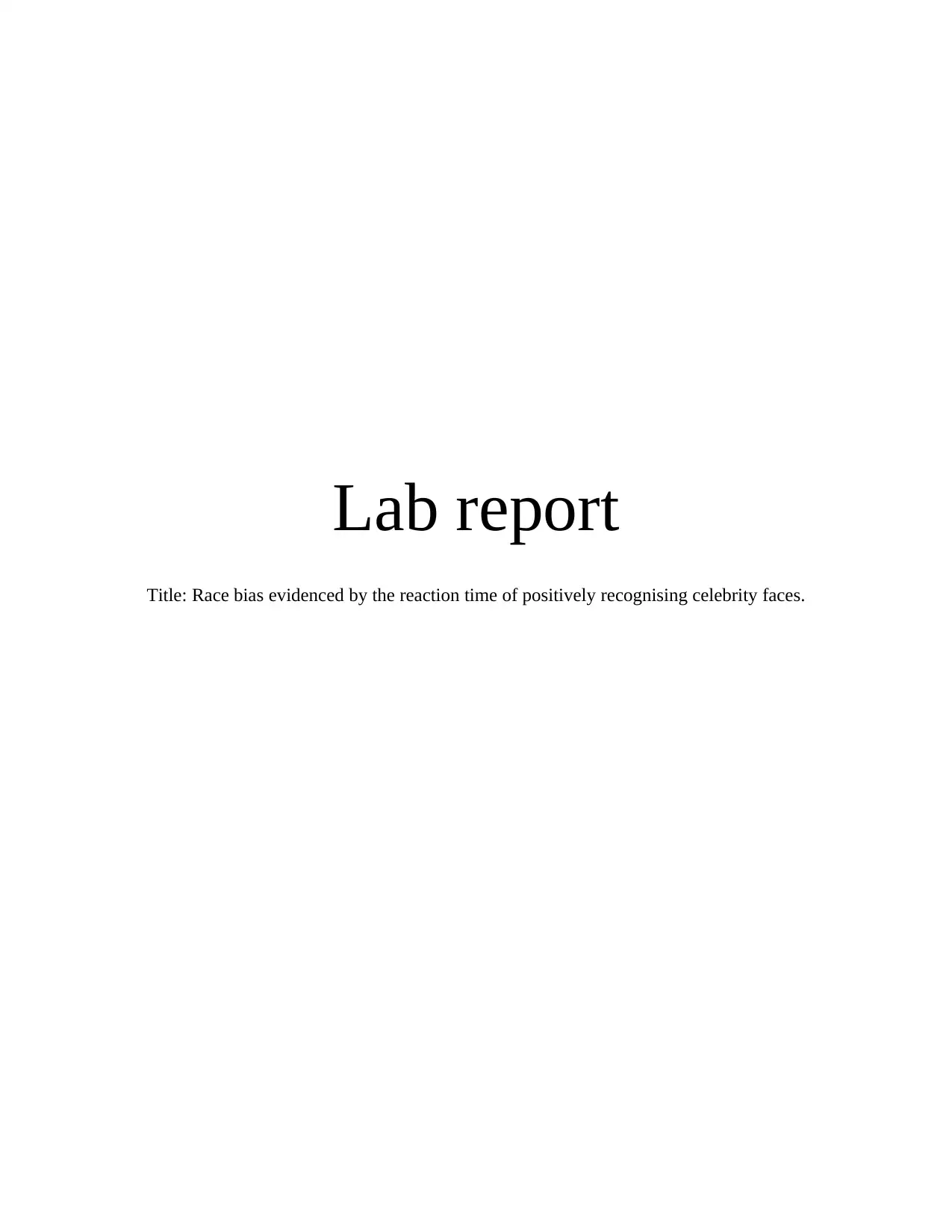
Lab report
Title: Race bias evidenced by the reaction time of positively recognising celebrity faces.
Title: Race bias evidenced by the reaction time of positively recognising celebrity faces.
Secure Best Marks with AI Grader
Need help grading? Try our AI Grader for instant feedback on your assignments.
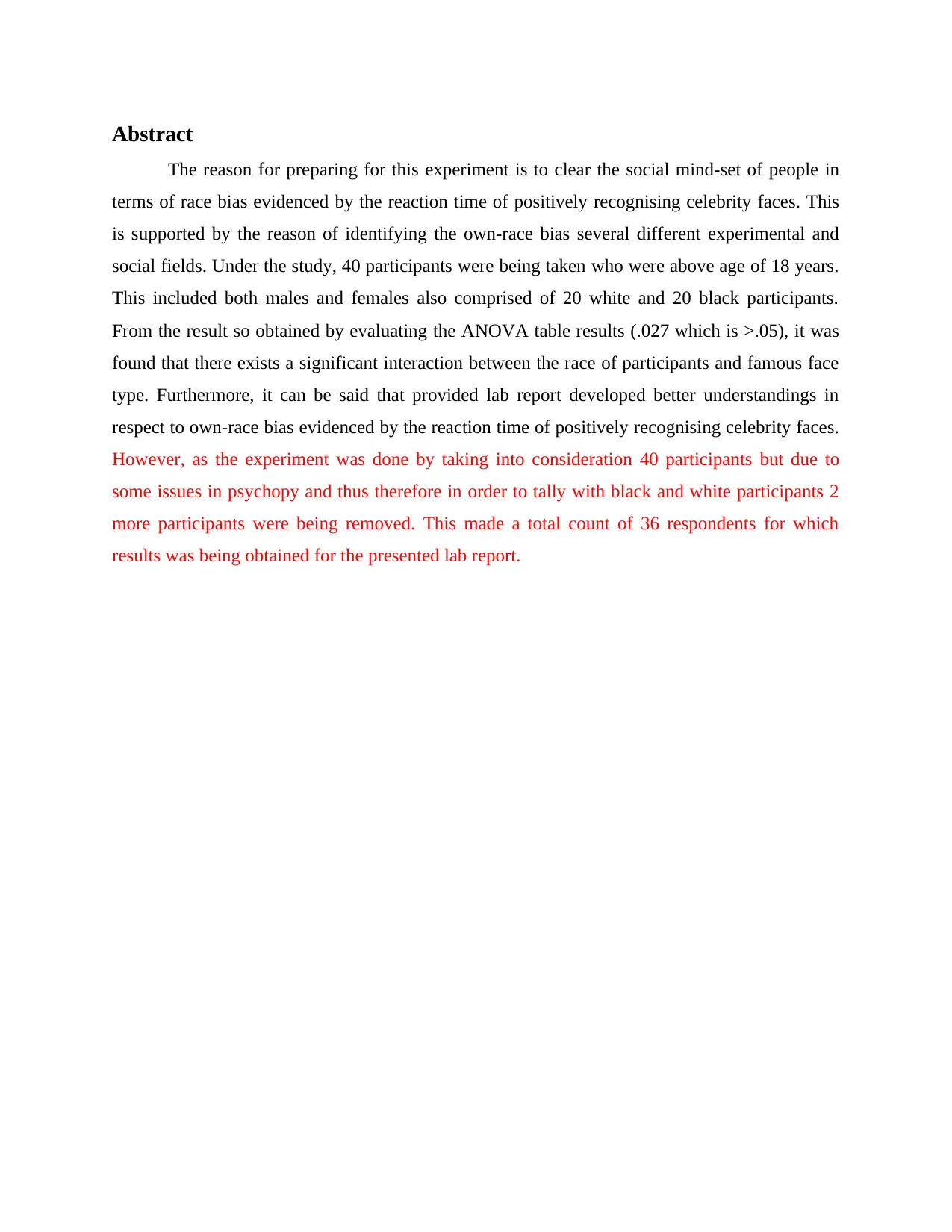
Abstract
The reason for preparing for this experiment is to clear the social mind-set of people in
terms of race bias evidenced by the reaction time of positively recognising celebrity faces. This
is supported by the reason of identifying the own-race bias several different experimental and
social fields. Under the study, 40 participants were being taken who were above age of 18 years.
This included both males and females also comprised of 20 white and 20 black participants.
From the result so obtained by evaluating the ANOVA table results (.027 which is >.05), it was
found that there exists a significant interaction between the race of participants and famous face
type. Furthermore, it can be said that provided lab report developed better understandings in
respect to own-race bias evidenced by the reaction time of positively recognising celebrity faces.
However, as the experiment was done by taking into consideration 40 participants but due to
some issues in psychopy and thus therefore in order to tally with black and white participants 2
more participants were being removed. This made a total count of 36 respondents for which
results was being obtained for the presented lab report.
The reason for preparing for this experiment is to clear the social mind-set of people in
terms of race bias evidenced by the reaction time of positively recognising celebrity faces. This
is supported by the reason of identifying the own-race bias several different experimental and
social fields. Under the study, 40 participants were being taken who were above age of 18 years.
This included both males and females also comprised of 20 white and 20 black participants.
From the result so obtained by evaluating the ANOVA table results (.027 which is >.05), it was
found that there exists a significant interaction between the race of participants and famous face
type. Furthermore, it can be said that provided lab report developed better understandings in
respect to own-race bias evidenced by the reaction time of positively recognising celebrity faces.
However, as the experiment was done by taking into consideration 40 participants but due to
some issues in psychopy and thus therefore in order to tally with black and white participants 2
more participants were being removed. This made a total count of 36 respondents for which
results was being obtained for the presented lab report.
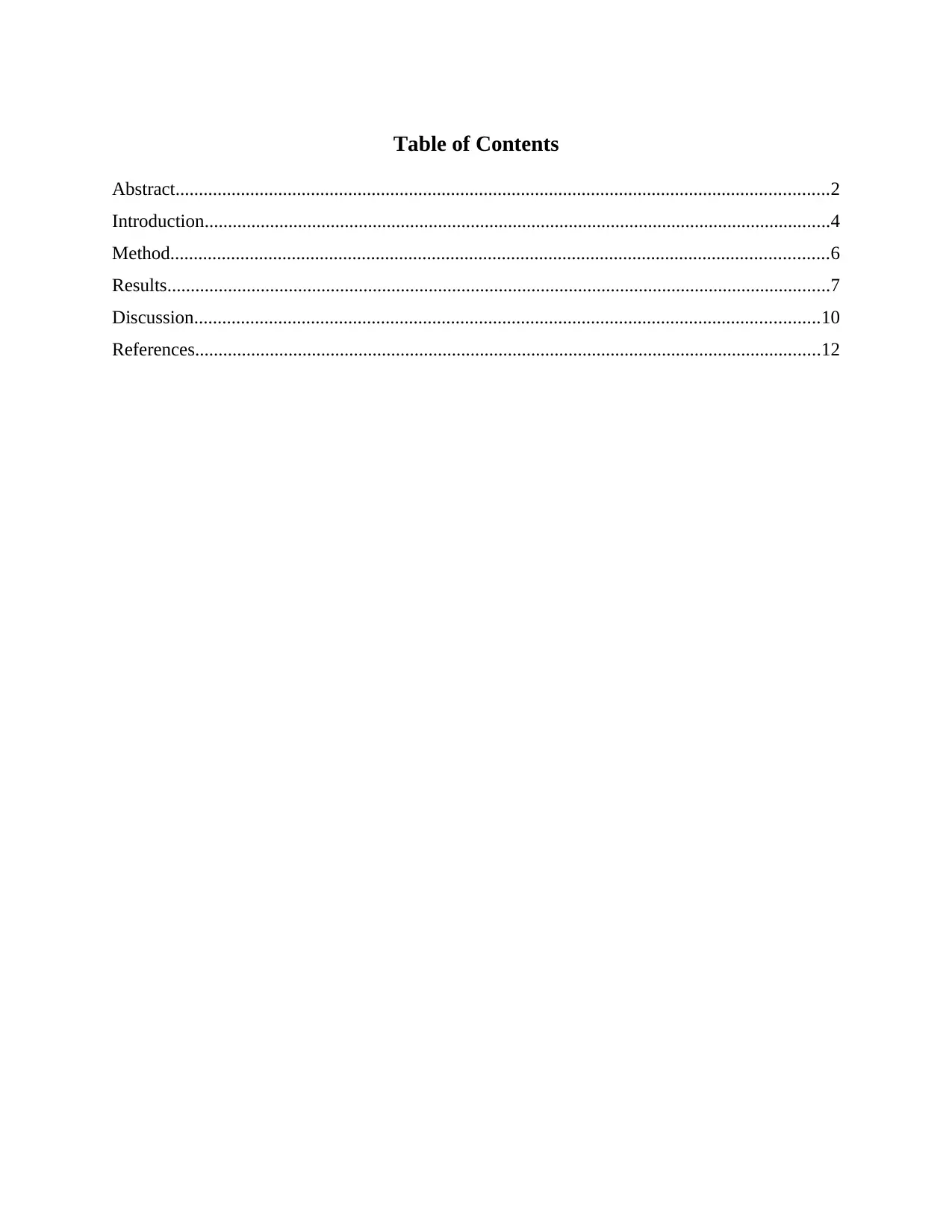
Table of Contents
Abstract............................................................................................................................................2
Introduction......................................................................................................................................4
Method.............................................................................................................................................6
Results..............................................................................................................................................7
Discussion......................................................................................................................................10
References......................................................................................................................................12
Abstract............................................................................................................................................2
Introduction......................................................................................................................................4
Method.............................................................................................................................................6
Results..............................................................................................................................................7
Discussion......................................................................................................................................10
References......................................................................................................................................12
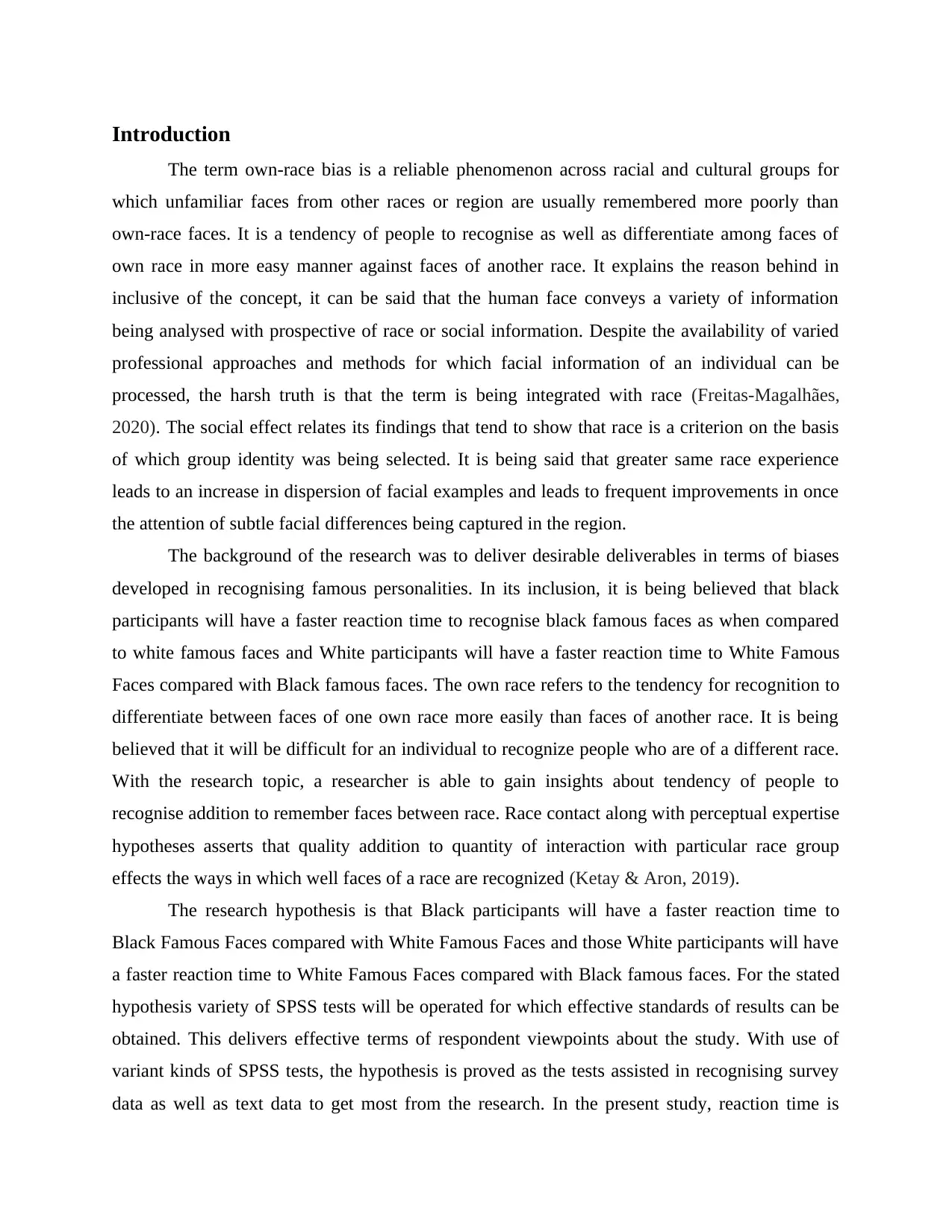
Introduction
The term own-race bias is a reliable phenomenon across racial and cultural groups for
which unfamiliar faces from other races or region are usually remembered more poorly than
own-race faces. It is a tendency of people to recognise as well as differentiate among faces of
own race in more easy manner against faces of another race. It explains the reason behind in
inclusive of the concept, it can be said that the human face conveys a variety of information
being analysed with prospective of race or social information. Despite the availability of varied
professional approaches and methods for which facial information of an individual can be
processed, the harsh truth is that the term is being integrated with race (Freitas-Magalhães,
2020). The social effect relates its findings that tend to show that race is a criterion on the basis
of which group identity was being selected. It is being said that greater same race experience
leads to an increase in dispersion of facial examples and leads to frequent improvements in once
the attention of subtle facial differences being captured in the region.
The background of the research was to deliver desirable deliverables in terms of biases
developed in recognising famous personalities. In its inclusion, it is being believed that black
participants will have a faster reaction time to recognise black famous faces as when compared
to white famous faces and White participants will have a faster reaction time to White Famous
Faces compared with Black famous faces. The own race refers to the tendency for recognition to
differentiate between faces of one own race more easily than faces of another race. It is being
believed that it will be difficult for an individual to recognize people who are of a different race.
With the research topic, a researcher is able to gain insights about tendency of people to
recognise addition to remember faces between race. Race contact along with perceptual expertise
hypotheses asserts that quality addition to quantity of interaction with particular race group
effects the ways in which well faces of a race are recognized (Ketay & Aron, 2019).
The research hypothesis is that Black participants will have a faster reaction time to
Black Famous Faces compared with White Famous Faces and those White participants will have
a faster reaction time to White Famous Faces compared with Black famous faces. For the stated
hypothesis variety of SPSS tests will be operated for which effective standards of results can be
obtained. This delivers effective terms of respondent viewpoints about the study. With use of
variant kinds of SPSS tests, the hypothesis is proved as the tests assisted in recognising survey
data as well as text data to get most from the research. In the present study, reaction time is
The term own-race bias is a reliable phenomenon across racial and cultural groups for
which unfamiliar faces from other races or region are usually remembered more poorly than
own-race faces. It is a tendency of people to recognise as well as differentiate among faces of
own race in more easy manner against faces of another race. It explains the reason behind in
inclusive of the concept, it can be said that the human face conveys a variety of information
being analysed with prospective of race or social information. Despite the availability of varied
professional approaches and methods for which facial information of an individual can be
processed, the harsh truth is that the term is being integrated with race (Freitas-Magalhães,
2020). The social effect relates its findings that tend to show that race is a criterion on the basis
of which group identity was being selected. It is being said that greater same race experience
leads to an increase in dispersion of facial examples and leads to frequent improvements in once
the attention of subtle facial differences being captured in the region.
The background of the research was to deliver desirable deliverables in terms of biases
developed in recognising famous personalities. In its inclusion, it is being believed that black
participants will have a faster reaction time to recognise black famous faces as when compared
to white famous faces and White participants will have a faster reaction time to White Famous
Faces compared with Black famous faces. The own race refers to the tendency for recognition to
differentiate between faces of one own race more easily than faces of another race. It is being
believed that it will be difficult for an individual to recognize people who are of a different race.
With the research topic, a researcher is able to gain insights about tendency of people to
recognise addition to remember faces between race. Race contact along with perceptual expertise
hypotheses asserts that quality addition to quantity of interaction with particular race group
effects the ways in which well faces of a race are recognized (Ketay & Aron, 2019).
The research hypothesis is that Black participants will have a faster reaction time to
Black Famous Faces compared with White Famous Faces and those White participants will have
a faster reaction time to White Famous Faces compared with Black famous faces. For the stated
hypothesis variety of SPSS tests will be operated for which effective standards of results can be
obtained. This delivers effective terms of respondent viewpoints about the study. With use of
variant kinds of SPSS tests, the hypothesis is proved as the tests assisted in recognising survey
data as well as text data to get most from the research. In the present study, reaction time is
Secure Best Marks with AI Grader
Need help grading? Try our AI Grader for instant feedback on your assignments.
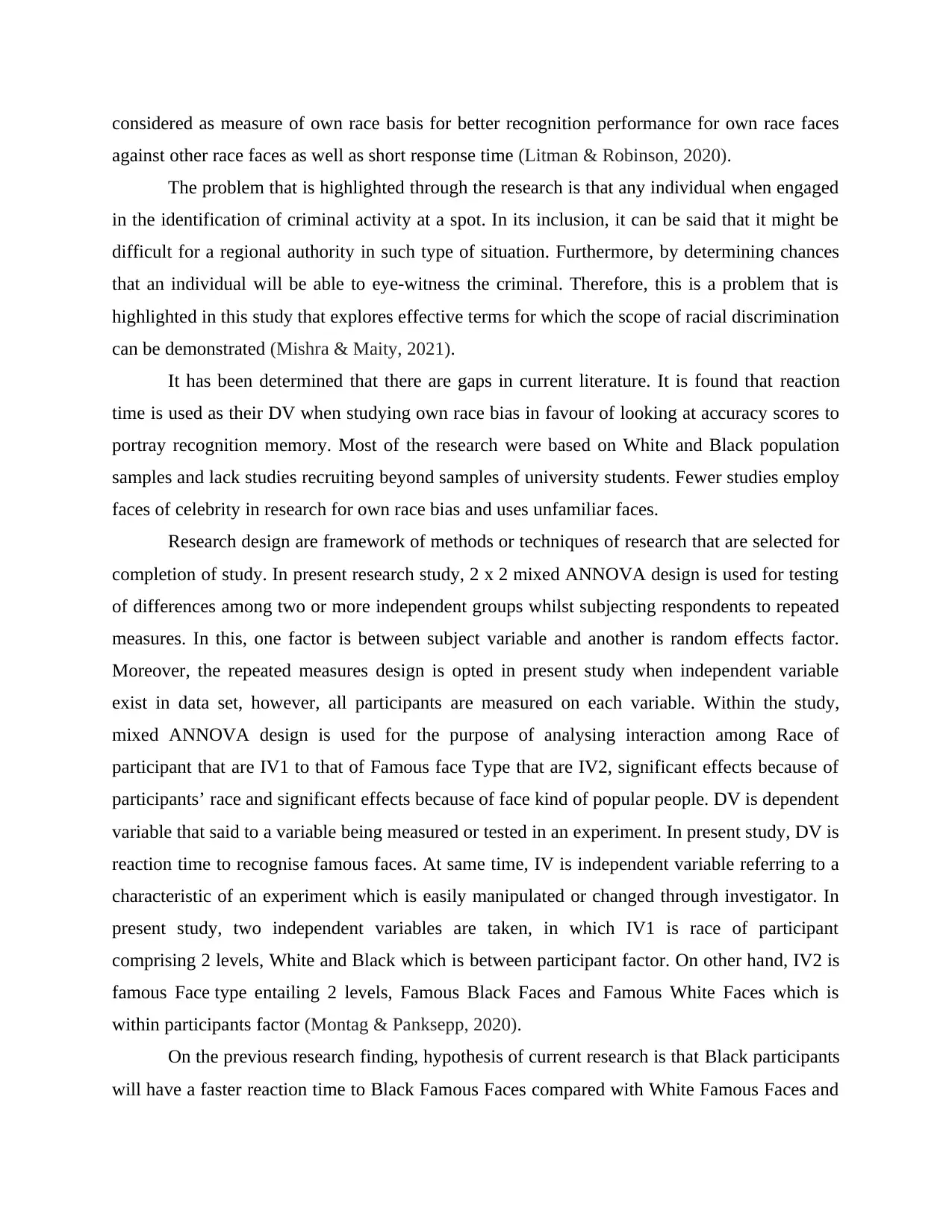
considered as measure of own race basis for better recognition performance for own race faces
against other race faces as well as short response time (Litman & Robinson, 2020).
The problem that is highlighted through the research is that any individual when engaged
in the identification of criminal activity at a spot. In its inclusion, it can be said that it might be
difficult for a regional authority in such type of situation. Furthermore, by determining chances
that an individual will be able to eye-witness the criminal. Therefore, this is a problem that is
highlighted in this study that explores effective terms for which the scope of racial discrimination
can be demonstrated (Mishra & Maity, 2021).
It has been determined that there are gaps in current literature. It is found that reaction
time is used as their DV when studying own race bias in favour of looking at accuracy scores to
portray recognition memory. Most of the research were based on White and Black population
samples and lack studies recruiting beyond samples of university students. Fewer studies employ
faces of celebrity in research for own race bias and uses unfamiliar faces.
Research design are framework of methods or techniques of research that are selected for
completion of study. In present research study, 2 x 2 mixed ANNOVA design is used for testing
of differences among two or more independent groups whilst subjecting respondents to repeated
measures. In this, one factor is between subject variable and another is random effects factor.
Moreover, the repeated measures design is opted in present study when independent variable
exist in data set, however, all participants are measured on each variable. Within the study,
mixed ANNOVA design is used for the purpose of analysing interaction among Race of
participant that are IV1 to that of Famous face Type that are IV2, significant effects because of
participants’ race and significant effects because of face kind of popular people. DV is dependent
variable that said to a variable being measured or tested in an experiment. In present study, DV is
reaction time to recognise famous faces. At same time, IV is independent variable referring to a
characteristic of an experiment which is easily manipulated or changed through investigator. In
present study, two independent variables are taken, in which IV1 is race of participant
comprising 2 levels, White and Black which is between participant factor. On other hand, IV2 is
famous Face type entailing 2 levels, Famous Black Faces and Famous White Faces which is
within participants factor (Montag & Panksepp, 2020).
On the previous research finding, hypothesis of current research is that Black participants
will have a faster reaction time to Black Famous Faces compared with White Famous Faces and
against other race faces as well as short response time (Litman & Robinson, 2020).
The problem that is highlighted through the research is that any individual when engaged
in the identification of criminal activity at a spot. In its inclusion, it can be said that it might be
difficult for a regional authority in such type of situation. Furthermore, by determining chances
that an individual will be able to eye-witness the criminal. Therefore, this is a problem that is
highlighted in this study that explores effective terms for which the scope of racial discrimination
can be demonstrated (Mishra & Maity, 2021).
It has been determined that there are gaps in current literature. It is found that reaction
time is used as their DV when studying own race bias in favour of looking at accuracy scores to
portray recognition memory. Most of the research were based on White and Black population
samples and lack studies recruiting beyond samples of university students. Fewer studies employ
faces of celebrity in research for own race bias and uses unfamiliar faces.
Research design are framework of methods or techniques of research that are selected for
completion of study. In present research study, 2 x 2 mixed ANNOVA design is used for testing
of differences among two or more independent groups whilst subjecting respondents to repeated
measures. In this, one factor is between subject variable and another is random effects factor.
Moreover, the repeated measures design is opted in present study when independent variable
exist in data set, however, all participants are measured on each variable. Within the study,
mixed ANNOVA design is used for the purpose of analysing interaction among Race of
participant that are IV1 to that of Famous face Type that are IV2, significant effects because of
participants’ race and significant effects because of face kind of popular people. DV is dependent
variable that said to a variable being measured or tested in an experiment. In present study, DV is
reaction time to recognise famous faces. At same time, IV is independent variable referring to a
characteristic of an experiment which is easily manipulated or changed through investigator. In
present study, two independent variables are taken, in which IV1 is race of participant
comprising 2 levels, White and Black which is between participant factor. On other hand, IV2 is
famous Face type entailing 2 levels, Famous Black Faces and Famous White Faces which is
within participants factor (Montag & Panksepp, 2020).
On the previous research finding, hypothesis of current research is that Black participants
will have a faster reaction time to Black Famous Faces compared with White Famous Faces and
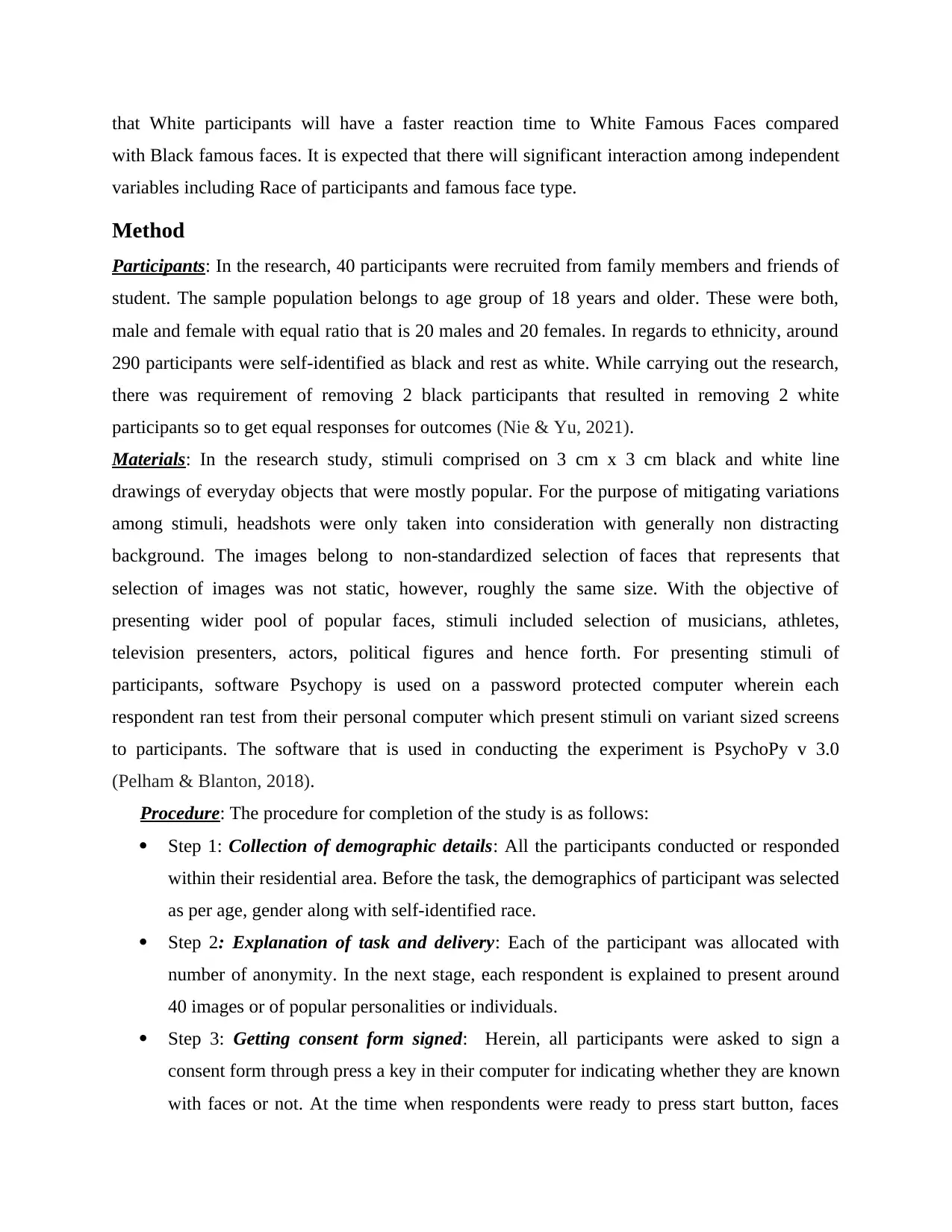
that White participants will have a faster reaction time to White Famous Faces compared
with Black famous faces. It is expected that there will significant interaction among independent
variables including Race of participants and famous face type.
Method
Participants: In the research, 40 participants were recruited from family members and friends of
student. The sample population belongs to age group of 18 years and older. These were both,
male and female with equal ratio that is 20 males and 20 females. In regards to ethnicity, around
290 participants were self-identified as black and rest as white. While carrying out the research,
there was requirement of removing 2 black participants that resulted in removing 2 white
participants so to get equal responses for outcomes (Nie & Yu, 2021).
Materials: In the research study, stimuli comprised on 3 cm x 3 cm black and white line
drawings of everyday objects that were mostly popular. For the purpose of mitigating variations
among stimuli, headshots were only taken into consideration with generally non distracting
background. The images belong to non-standardized selection of faces that represents that
selection of images was not static, however, roughly the same size. With the objective of
presenting wider pool of popular faces, stimuli included selection of musicians, athletes,
television presenters, actors, political figures and hence forth. For presenting stimuli of
participants, software Psychopy is used on a password protected computer wherein each
respondent ran test from their personal computer which present stimuli on variant sized screens
to participants. The software that is used in conducting the experiment is PsychoPy v 3.0
(Pelham & Blanton, 2018).
Procedure: The procedure for completion of the study is as follows:
Step 1: Collection of demographic details: All the participants conducted or responded
within their residential area. Before the task, the demographics of participant was selected
as per age, gender along with self-identified race.
Step 2: Explanation of task and delivery: Each of the participant was allocated with
number of anonymity. In the next stage, each respondent is explained to present around
40 images or of popular personalities or individuals.
Step 3: Getting consent form signed: Herein, all participants were asked to sign a
consent form through press a key in their computer for indicating whether they are known
with faces or not. At the time when respondents were ready to press start button, faces
with Black famous faces. It is expected that there will significant interaction among independent
variables including Race of participants and famous face type.
Method
Participants: In the research, 40 participants were recruited from family members and friends of
student. The sample population belongs to age group of 18 years and older. These were both,
male and female with equal ratio that is 20 males and 20 females. In regards to ethnicity, around
290 participants were self-identified as black and rest as white. While carrying out the research,
there was requirement of removing 2 black participants that resulted in removing 2 white
participants so to get equal responses for outcomes (Nie & Yu, 2021).
Materials: In the research study, stimuli comprised on 3 cm x 3 cm black and white line
drawings of everyday objects that were mostly popular. For the purpose of mitigating variations
among stimuli, headshots were only taken into consideration with generally non distracting
background. The images belong to non-standardized selection of faces that represents that
selection of images was not static, however, roughly the same size. With the objective of
presenting wider pool of popular faces, stimuli included selection of musicians, athletes,
television presenters, actors, political figures and hence forth. For presenting stimuli of
participants, software Psychopy is used on a password protected computer wherein each
respondent ran test from their personal computer which present stimuli on variant sized screens
to participants. The software that is used in conducting the experiment is PsychoPy v 3.0
(Pelham & Blanton, 2018).
Procedure: The procedure for completion of the study is as follows:
Step 1: Collection of demographic details: All the participants conducted or responded
within their residential area. Before the task, the demographics of participant was selected
as per age, gender along with self-identified race.
Step 2: Explanation of task and delivery: Each of the participant was allocated with
number of anonymity. In the next stage, each respondent is explained to present around
40 images or of popular personalities or individuals.
Step 3: Getting consent form signed: Herein, all participants were asked to sign a
consent form through press a key in their computer for indicating whether they are known
with faces or not. At the time when respondents were ready to press start button, faces
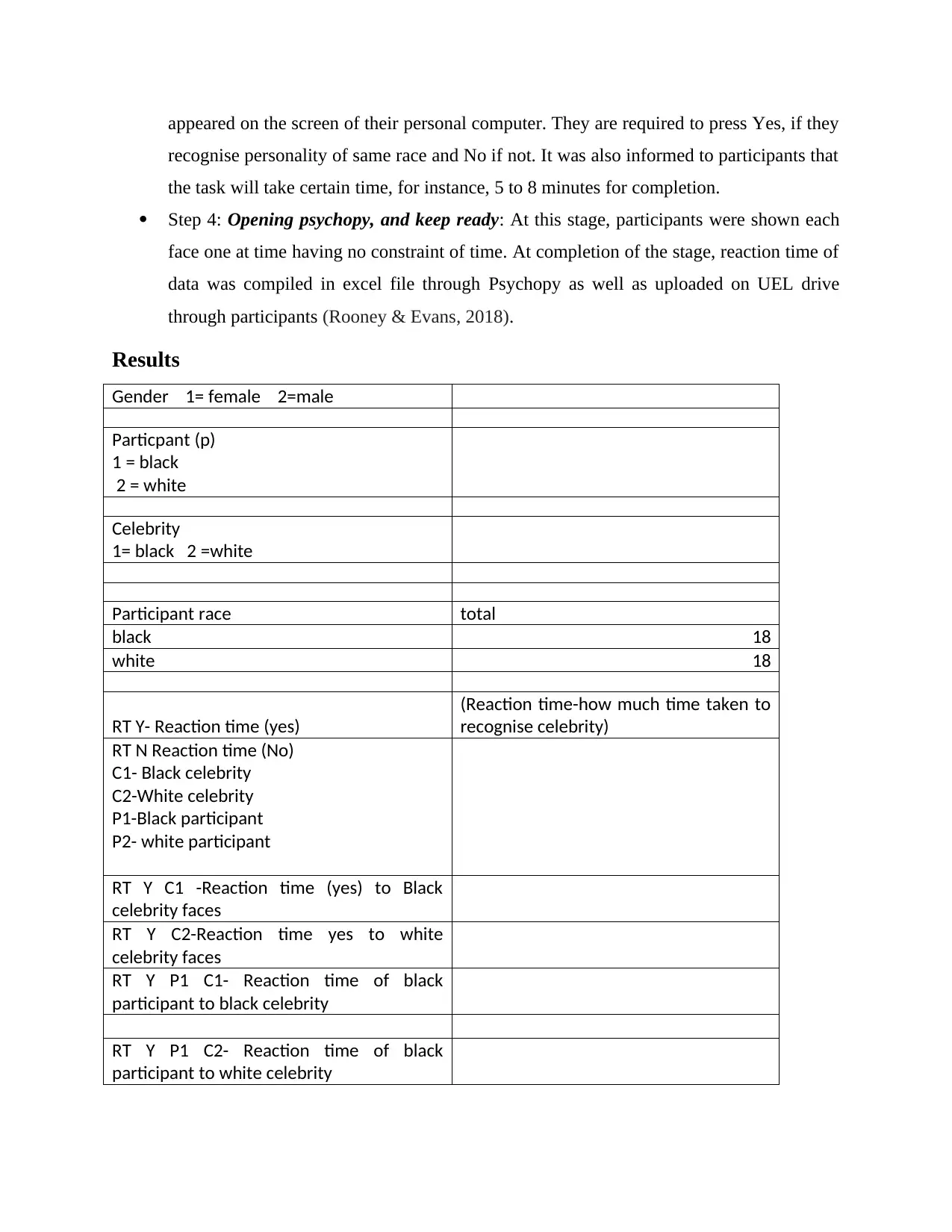
appeared on the screen of their personal computer. They are required to press Yes, if they
recognise personality of same race and No if not. It was also informed to participants that
the task will take certain time, for instance, 5 to 8 minutes for completion.
Step 4: Opening psychopy, and keep ready: At this stage, participants were shown each
face one at time having no constraint of time. At completion of the stage, reaction time of
data was compiled in excel file through Psychopy as well as uploaded on UEL drive
through participants (Rooney & Evans, 2018).
Results
Gender 1= female 2=male
Particpant (p)
1 = black
2 = white
Celebrity
1= black 2 =white
Participant race total
black 18
white 18
RT Y- Reaction time (yes)
(Reaction time-how much time taken to
recognise celebrity)
RT N Reaction time (No)
C1- Black celebrity
C2-White celebrity
P1-Black participant
P2- white participant
RT Y C1 -Reaction time (yes) to Black
celebrity faces
RT Y C2-Reaction time yes to white
celebrity faces
RT Y P1 C1- Reaction time of black
participant to black celebrity
RT Y P1 C2- Reaction time of black
participant to white celebrity
recognise personality of same race and No if not. It was also informed to participants that
the task will take certain time, for instance, 5 to 8 minutes for completion.
Step 4: Opening psychopy, and keep ready: At this stage, participants were shown each
face one at time having no constraint of time. At completion of the stage, reaction time of
data was compiled in excel file through Psychopy as well as uploaded on UEL drive
through participants (Rooney & Evans, 2018).
Results
Gender 1= female 2=male
Particpant (p)
1 = black
2 = white
Celebrity
1= black 2 =white
Participant race total
black 18
white 18
RT Y- Reaction time (yes)
(Reaction time-how much time taken to
recognise celebrity)
RT N Reaction time (No)
C1- Black celebrity
C2-White celebrity
P1-Black participant
P2- white participant
RT Y C1 -Reaction time (yes) to Black
celebrity faces
RT Y C2-Reaction time yes to white
celebrity faces
RT Y P1 C1- Reaction time of black
participant to black celebrity
RT Y P1 C2- Reaction time of black
participant to white celebrity
Paraphrase This Document
Need a fresh take? Get an instant paraphrase of this document with our AI Paraphraser
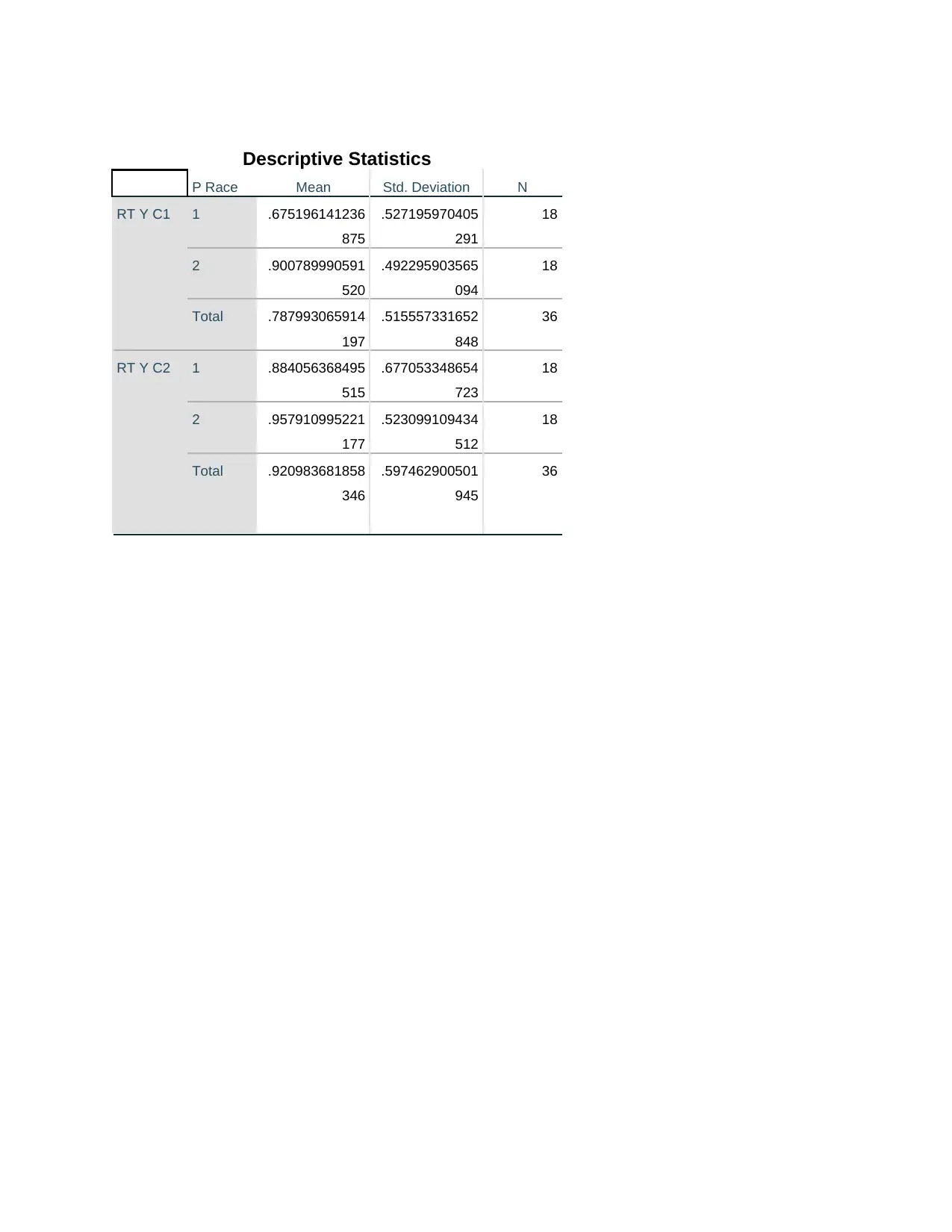
Descriptive Statistics
P Race Mean Std. Deviation N
RT Y C1 1 .675196141236
875
.527195970405
291
18
2 .900789990591
520
.492295903565
094
18
Total .787993065914
197
.515557331652
848
36
RT Y C2 1 .884056368495
515
.677053348654
723
18
2 .957910995221
177
.523099109434
512
18
Total .920983681858
346
.597462900501
945
36
P Race Mean Std. Deviation N
RT Y C1 1 .675196141236
875
.527195970405
291
18
2 .900789990591
520
.492295903565
094
18
Total .787993065914
197
.515557331652
848
36
RT Y C2 1 .884056368495
515
.677053348654
723
18
2 .957910995221
177
.523099109434
512
18
Total .920983681858
346
.597462900501
945
36
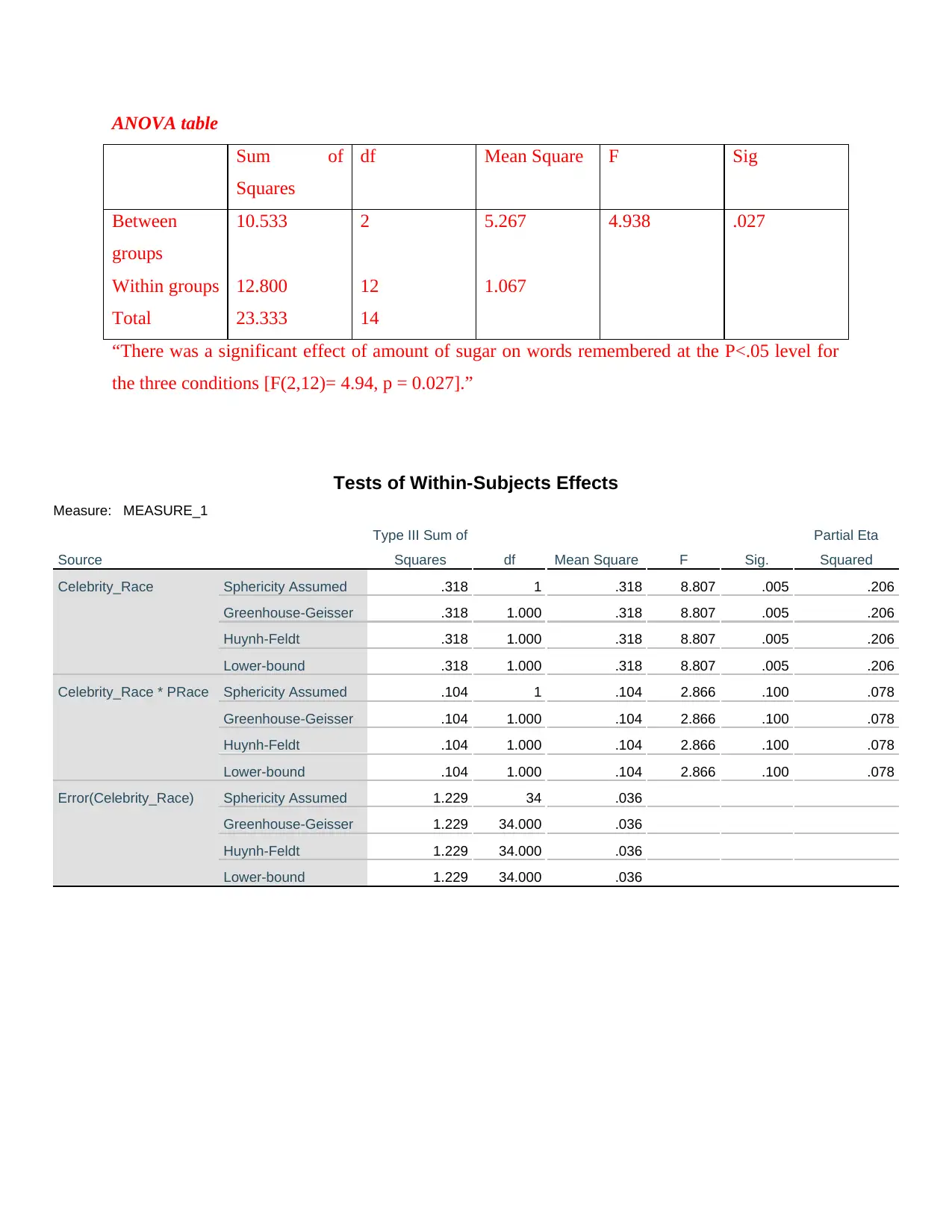
ANOVA table
Sum of
Squares
df Mean Square F Sig
Between
groups
Within groups
Total
10.533
12.800
23.333
2
12
14
5.267
1.067
4.938 .027
“There was a significant effect of amount of sugar on words remembered at the P<.05 level for
the three conditions [F(2,12)= 4.94, p = 0.027].”
Tests of Within-Subjects Effects
Measure: MEASURE_1
Source
Type III Sum of
Squares df Mean Square F Sig.
Partial Eta
Squared
Celebrity_Race Sphericity Assumed .318 1 .318 8.807 .005 .206
Greenhouse-Geisser .318 1.000 .318 8.807 .005 .206
Huynh-Feldt .318 1.000 .318 8.807 .005 .206
Lower-bound .318 1.000 .318 8.807 .005 .206
Celebrity_Race * PRace Sphericity Assumed .104 1 .104 2.866 .100 .078
Greenhouse-Geisser .104 1.000 .104 2.866 .100 .078
Huynh-Feldt .104 1.000 .104 2.866 .100 .078
Lower-bound .104 1.000 .104 2.866 .100 .078
Error(Celebrity_Race) Sphericity Assumed 1.229 34 .036
Greenhouse-Geisser 1.229 34.000 .036
Huynh-Feldt 1.229 34.000 .036
Lower-bound 1.229 34.000 .036
Sum of
Squares
df Mean Square F Sig
Between
groups
Within groups
Total
10.533
12.800
23.333
2
12
14
5.267
1.067
4.938 .027
“There was a significant effect of amount of sugar on words remembered at the P<.05 level for
the three conditions [F(2,12)= 4.94, p = 0.027].”
Tests of Within-Subjects Effects
Measure: MEASURE_1
Source
Type III Sum of
Squares df Mean Square F Sig.
Partial Eta
Squared
Celebrity_Race Sphericity Assumed .318 1 .318 8.807 .005 .206
Greenhouse-Geisser .318 1.000 .318 8.807 .005 .206
Huynh-Feldt .318 1.000 .318 8.807 .005 .206
Lower-bound .318 1.000 .318 8.807 .005 .206
Celebrity_Race * PRace Sphericity Assumed .104 1 .104 2.866 .100 .078
Greenhouse-Geisser .104 1.000 .104 2.866 .100 .078
Huynh-Feldt .104 1.000 .104 2.866 .100 .078
Lower-bound .104 1.000 .104 2.866 .100 .078
Error(Celebrity_Race) Sphericity Assumed 1.229 34 .036
Greenhouse-Geisser 1.229 34.000 .036
Huynh-Feldt 1.229 34.000 .036
Lower-bound 1.229 34.000 .036
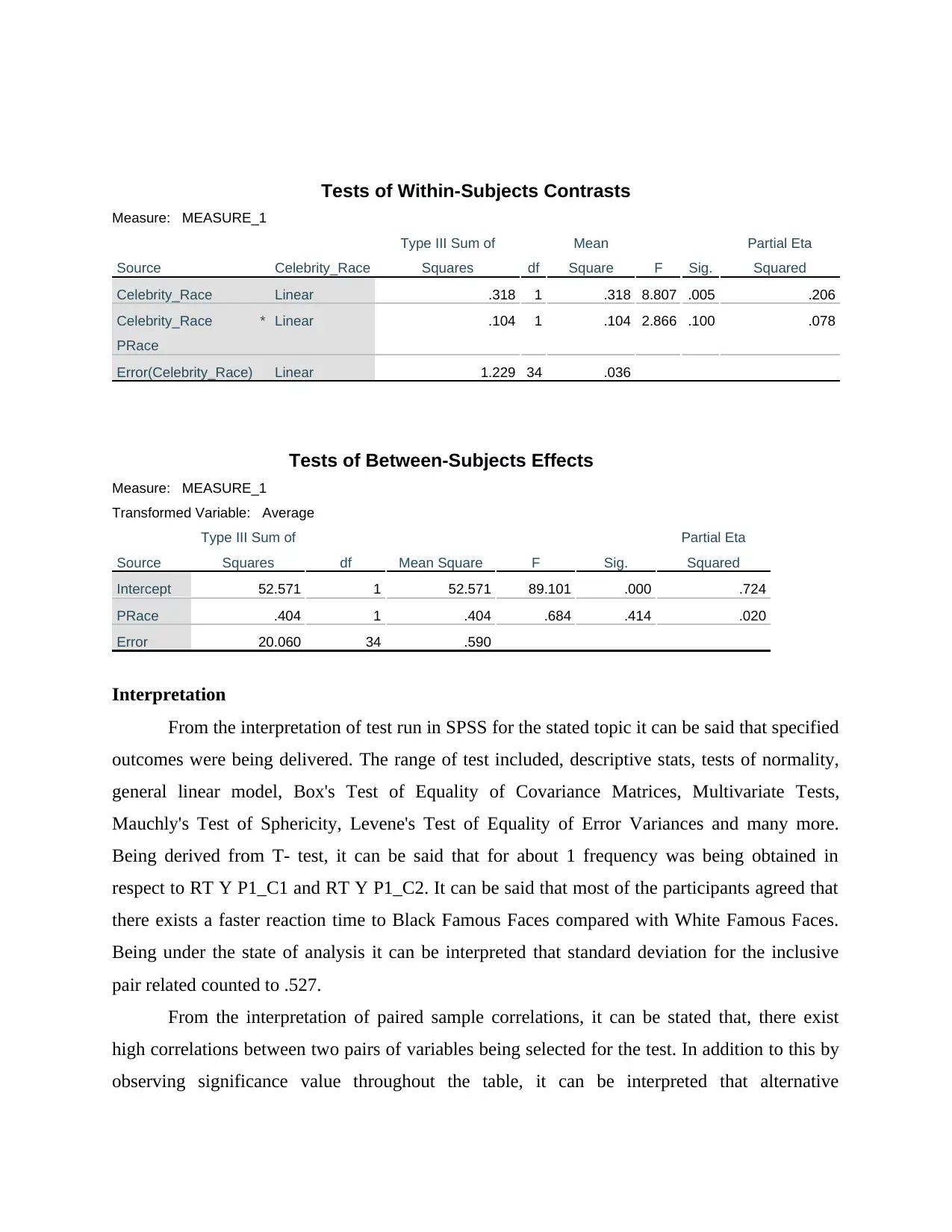
Tests of Within-Subjects Contrasts
Measure: MEASURE_1
Source Celebrity_Race
Type III Sum of
Squares df
Mean
Square F Sig.
Partial Eta
Squared
Celebrity_Race Linear .318 1 .318 8.807 .005 .206
Celebrity_Race *
PRace
Linear .104 1 .104 2.866 .100 .078
Error(Celebrity_Race) Linear 1.229 34 .036
Tests of Between-Subjects Effects
Measure: MEASURE_1
Transformed Variable: Average
Source
Type III Sum of
Squares df Mean Square F Sig.
Partial Eta
Squared
Intercept 52.571 1 52.571 89.101 .000 .724
PRace .404 1 .404 .684 .414 .020
Error 20.060 34 .590
Interpretation
From the interpretation of test run in SPSS for the stated topic it can be said that specified
outcomes were being delivered. The range of test included, descriptive stats, tests of normality,
general linear model, Box's Test of Equality of Covariance Matrices, Multivariate Tests,
Mauchly's Test of Sphericity, Levene's Test of Equality of Error Variances and many more.
Being derived from T- test, it can be said that for about 1 frequency was being obtained in
respect to RT Y P1_C1 and RT Y P1_C2. It can be said that most of the participants agreed that
there exists a faster reaction time to Black Famous Faces compared with White Famous Faces.
Being under the state of analysis it can be interpreted that standard deviation for the inclusive
pair related counted to .527.
From the interpretation of paired sample correlations, it can be stated that, there exist
high correlations between two pairs of variables being selected for the test. In addition to this by
observing significance value throughout the table, it can be interpreted that alternative
Measure: MEASURE_1
Source Celebrity_Race
Type III Sum of
Squares df
Mean
Square F Sig.
Partial Eta
Squared
Celebrity_Race Linear .318 1 .318 8.807 .005 .206
Celebrity_Race *
PRace
Linear .104 1 .104 2.866 .100 .078
Error(Celebrity_Race) Linear 1.229 34 .036
Tests of Between-Subjects Effects
Measure: MEASURE_1
Transformed Variable: Average
Source
Type III Sum of
Squares df Mean Square F Sig.
Partial Eta
Squared
Intercept 52.571 1 52.571 89.101 .000 .724
PRace .404 1 .404 .684 .414 .020
Error 20.060 34 .590
Interpretation
From the interpretation of test run in SPSS for the stated topic it can be said that specified
outcomes were being delivered. The range of test included, descriptive stats, tests of normality,
general linear model, Box's Test of Equality of Covariance Matrices, Multivariate Tests,
Mauchly's Test of Sphericity, Levene's Test of Equality of Error Variances and many more.
Being derived from T- test, it can be said that for about 1 frequency was being obtained in
respect to RT Y P1_C1 and RT Y P1_C2. It can be said that most of the participants agreed that
there exists a faster reaction time to Black Famous Faces compared with White Famous Faces.
Being under the state of analysis it can be interpreted that standard deviation for the inclusive
pair related counted to .527.
From the interpretation of paired sample correlations, it can be stated that, there exist
high correlations between two pairs of variables being selected for the test. In addition to this by
observing significance value throughout the table, it can be interpreted that alternative
Secure Best Marks with AI Grader
Need help grading? Try our AI Grader for instant feedback on your assignments.
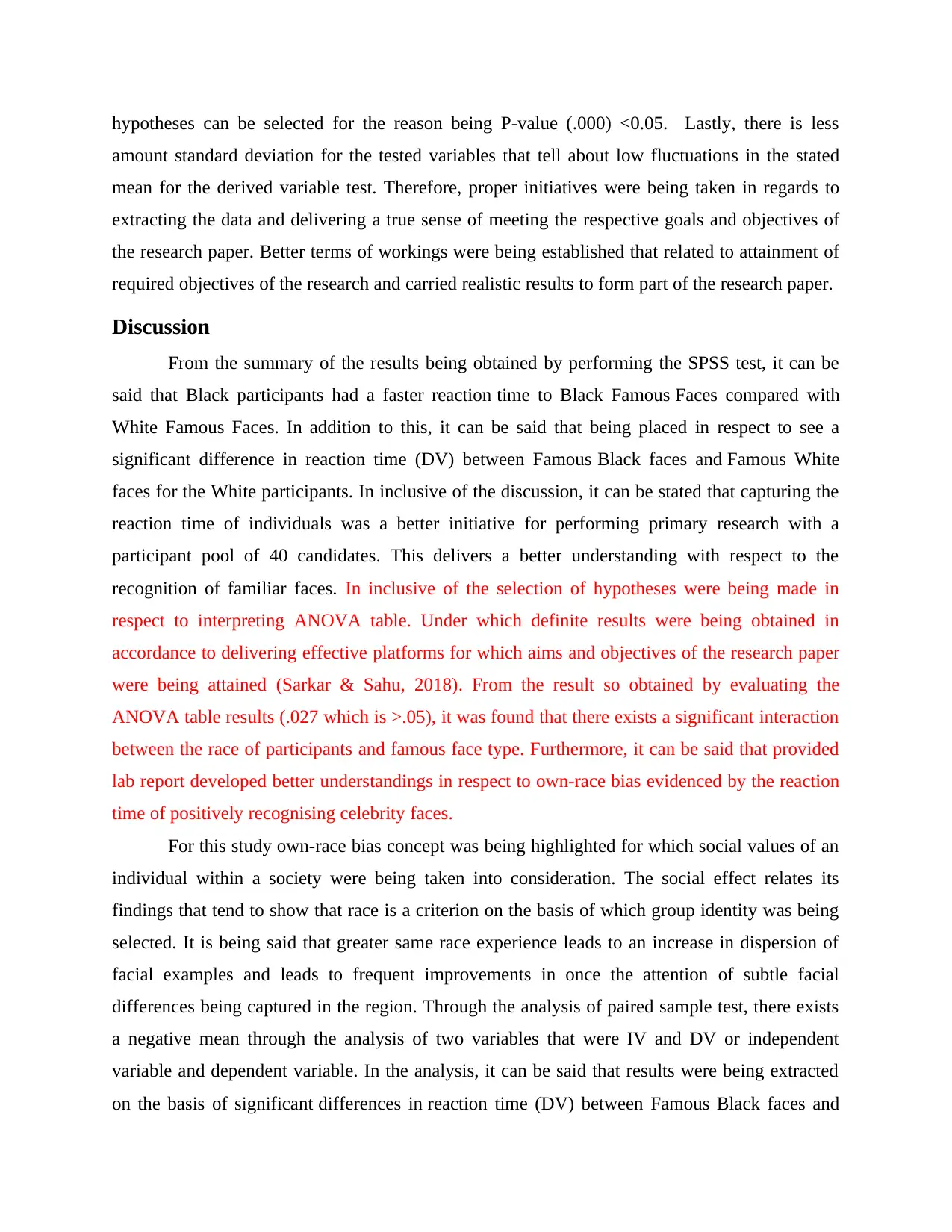
hypotheses can be selected for the reason being P-value (.000) <0.05. Lastly, there is less
amount standard deviation for the tested variables that tell about low fluctuations in the stated
mean for the derived variable test. Therefore, proper initiatives were being taken in regards to
extracting the data and delivering a true sense of meeting the respective goals and objectives of
the research paper. Better terms of workings were being established that related to attainment of
required objectives of the research and carried realistic results to form part of the research paper.
Discussion
From the summary of the results being obtained by performing the SPSS test, it can be
said that Black participants had a faster reaction time to Black Famous Faces compared with
White Famous Faces. In addition to this, it can be said that being placed in respect to see a
significant difference in reaction time (DV) between Famous Black faces and Famous White
faces for the White participants. In inclusive of the discussion, it can be stated that capturing the
reaction time of individuals was a better initiative for performing primary research with a
participant pool of 40 candidates. This delivers a better understanding with respect to the
recognition of familiar faces. In inclusive of the selection of hypotheses were being made in
respect to interpreting ANOVA table. Under which definite results were being obtained in
accordance to delivering effective platforms for which aims and objectives of the research paper
were being attained (Sarkar & Sahu, 2018). From the result so obtained by evaluating the
ANOVA table results (.027 which is >.05), it was found that there exists a significant interaction
between the race of participants and famous face type. Furthermore, it can be said that provided
lab report developed better understandings in respect to own-race bias evidenced by the reaction
time of positively recognising celebrity faces.
For this study own-race bias concept was being highlighted for which social values of an
individual within a society were being taken into consideration. The social effect relates its
findings that tend to show that race is a criterion on the basis of which group identity was being
selected. It is being said that greater same race experience leads to an increase in dispersion of
facial examples and leads to frequent improvements in once the attention of subtle facial
differences being captured in the region. Through the analysis of paired sample test, there exists
a negative mean through the analysis of two variables that were IV and DV or independent
variable and dependent variable. In the analysis, it can be said that results were being extracted
on the basis of significant differences in reaction time (DV) between Famous Black faces and
amount standard deviation for the tested variables that tell about low fluctuations in the stated
mean for the derived variable test. Therefore, proper initiatives were being taken in regards to
extracting the data and delivering a true sense of meeting the respective goals and objectives of
the research paper. Better terms of workings were being established that related to attainment of
required objectives of the research and carried realistic results to form part of the research paper.
Discussion
From the summary of the results being obtained by performing the SPSS test, it can be
said that Black participants had a faster reaction time to Black Famous Faces compared with
White Famous Faces. In addition to this, it can be said that being placed in respect to see a
significant difference in reaction time (DV) between Famous Black faces and Famous White
faces for the White participants. In inclusive of the discussion, it can be stated that capturing the
reaction time of individuals was a better initiative for performing primary research with a
participant pool of 40 candidates. This delivers a better understanding with respect to the
recognition of familiar faces. In inclusive of the selection of hypotheses were being made in
respect to interpreting ANOVA table. Under which definite results were being obtained in
accordance to delivering effective platforms for which aims and objectives of the research paper
were being attained (Sarkar & Sahu, 2018). From the result so obtained by evaluating the
ANOVA table results (.027 which is >.05), it was found that there exists a significant interaction
between the race of participants and famous face type. Furthermore, it can be said that provided
lab report developed better understandings in respect to own-race bias evidenced by the reaction
time of positively recognising celebrity faces.
For this study own-race bias concept was being highlighted for which social values of an
individual within a society were being taken into consideration. The social effect relates its
findings that tend to show that race is a criterion on the basis of which group identity was being
selected. It is being said that greater same race experience leads to an increase in dispersion of
facial examples and leads to frequent improvements in once the attention of subtle facial
differences being captured in the region. Through the analysis of paired sample test, there exists
a negative mean through the analysis of two variables that were IV and DV or independent
variable and dependent variable. In the analysis, it can be said that results were being extracted
on the basis of significant differences in reaction time (DV) between Famous Black faces and
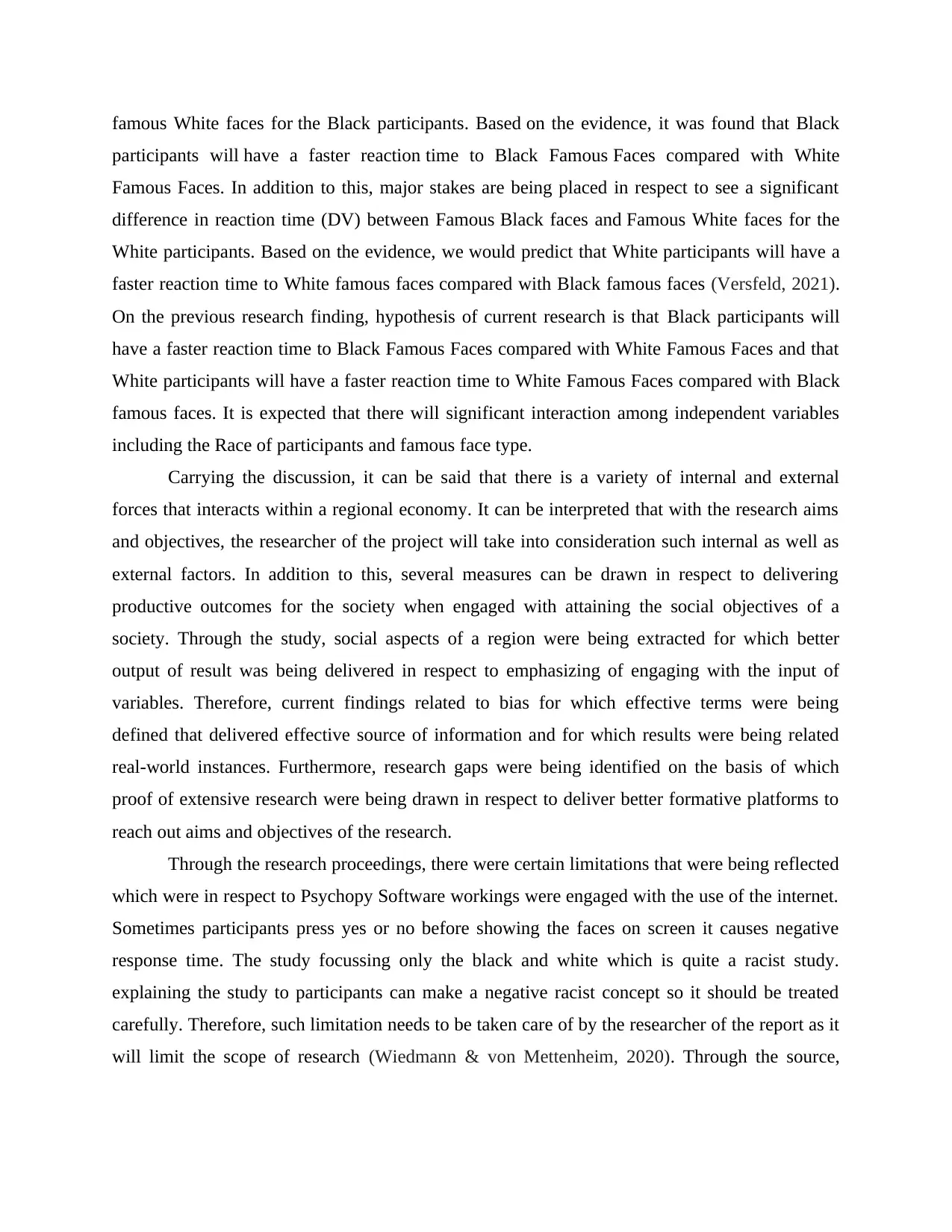
famous White faces for the Black participants. Based on the evidence, it was found that Black
participants will have a faster reaction time to Black Famous Faces compared with White
Famous Faces. In addition to this, major stakes are being placed in respect to see a significant
difference in reaction time (DV) between Famous Black faces and Famous White faces for the
White participants. Based on the evidence, we would predict that White participants will have a
faster reaction time to White famous faces compared with Black famous faces (Versfeld, 2021).
On the previous research finding, hypothesis of current research is that Black participants will
have a faster reaction time to Black Famous Faces compared with White Famous Faces and that
White participants will have a faster reaction time to White Famous Faces compared with Black
famous faces. It is expected that there will significant interaction among independent variables
including the Race of participants and famous face type.
Carrying the discussion, it can be said that there is a variety of internal and external
forces that interacts within a regional economy. It can be interpreted that with the research aims
and objectives, the researcher of the project will take into consideration such internal as well as
external factors. In addition to this, several measures can be drawn in respect to delivering
productive outcomes for the society when engaged with attaining the social objectives of a
society. Through the study, social aspects of a region were being extracted for which better
output of result was being delivered in respect to emphasizing of engaging with the input of
variables. Therefore, current findings related to bias for which effective terms were being
defined that delivered effective source of information and for which results were being related
real-world instances. Furthermore, research gaps were being identified on the basis of which
proof of extensive research were being drawn in respect to deliver better formative platforms to
reach out aims and objectives of the research.
Through the research proceedings, there were certain limitations that were being reflected
which were in respect to Psychopy Software workings were engaged with the use of the internet.
Sometimes participants press yes or no before showing the faces on screen it causes negative
response time. The study focussing only the black and white which is quite a racist study.
explaining the study to participants can make a negative racist concept so it should be treated
carefully. Therefore, such limitation needs to be taken care of by the researcher of the report as it
will limit the scope of research (Wiedmann & von Mettenheim, 2020). Through the source,
participants will have a faster reaction time to Black Famous Faces compared with White
Famous Faces. In addition to this, major stakes are being placed in respect to see a significant
difference in reaction time (DV) between Famous Black faces and Famous White faces for the
White participants. Based on the evidence, we would predict that White participants will have a
faster reaction time to White famous faces compared with Black famous faces (Versfeld, 2021).
On the previous research finding, hypothesis of current research is that Black participants will
have a faster reaction time to Black Famous Faces compared with White Famous Faces and that
White participants will have a faster reaction time to White Famous Faces compared with Black
famous faces. It is expected that there will significant interaction among independent variables
including the Race of participants and famous face type.
Carrying the discussion, it can be said that there is a variety of internal and external
forces that interacts within a regional economy. It can be interpreted that with the research aims
and objectives, the researcher of the project will take into consideration such internal as well as
external factors. In addition to this, several measures can be drawn in respect to delivering
productive outcomes for the society when engaged with attaining the social objectives of a
society. Through the study, social aspects of a region were being extracted for which better
output of result was being delivered in respect to emphasizing of engaging with the input of
variables. Therefore, current findings related to bias for which effective terms were being
defined that delivered effective source of information and for which results were being related
real-world instances. Furthermore, research gaps were being identified on the basis of which
proof of extensive research were being drawn in respect to deliver better formative platforms to
reach out aims and objectives of the research.
Through the research proceedings, there were certain limitations that were being reflected
which were in respect to Psychopy Software workings were engaged with the use of the internet.
Sometimes participants press yes or no before showing the faces on screen it causes negative
response time. The study focussing only the black and white which is quite a racist study.
explaining the study to participants can make a negative racist concept so it should be treated
carefully. Therefore, such limitation needs to be taken care of by the researcher of the report as it
will limit the scope of research (Wiedmann & von Mettenheim, 2020). Through the source,

effective outcomes were being delivered that were in respect to proving to better results that
were being defined by outcomes so obtained by test.
were being defined by outcomes so obtained by test.
Paraphrase This Document
Need a fresh take? Get an instant paraphrase of this document with our AI Paraphraser
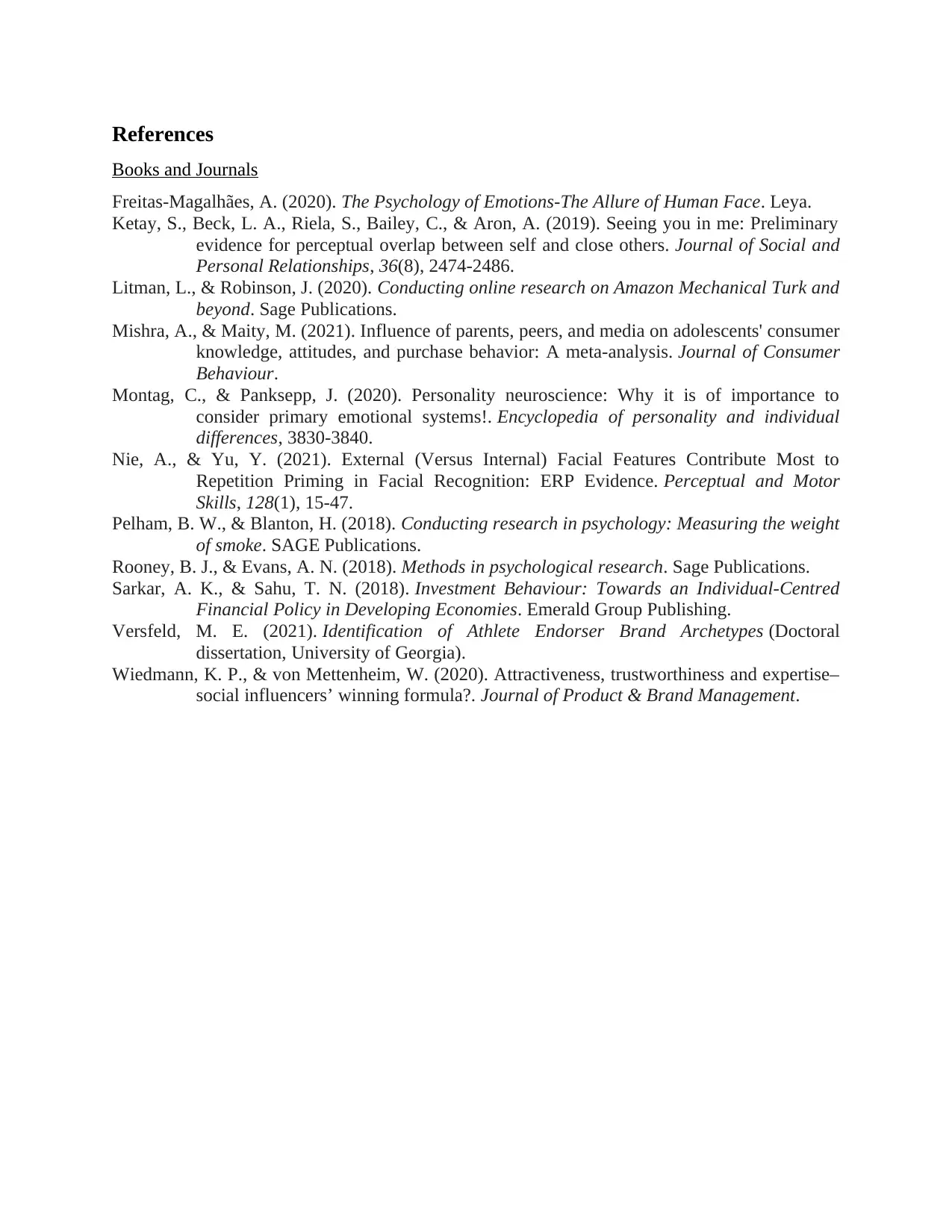
References
Books and Journals
Freitas-Magalhães, A. (2020). The Psychology of Emotions-The Allure of Human Face. Leya.
Ketay, S., Beck, L. A., Riela, S., Bailey, C., & Aron, A. (2019). Seeing you in me: Preliminary
evidence for perceptual overlap between self and close others. Journal of Social and
Personal Relationships, 36(8), 2474-2486.
Litman, L., & Robinson, J. (2020). Conducting online research on Amazon Mechanical Turk and
beyond. Sage Publications.
Mishra, A., & Maity, M. (2021). Influence of parents, peers, and media on adolescents' consumer
knowledge, attitudes, and purchase behavior: A meta‐analysis. Journal of Consumer
Behaviour.
Montag, C., & Panksepp, J. (2020). Personality neuroscience: Why it is of importance to
consider primary emotional systems!. Encyclopedia of personality and individual
differences, 3830-3840.
Nie, A., & Yu, Y. (2021). External (Versus Internal) Facial Features Contribute Most to
Repetition Priming in Facial Recognition: ERP Evidence. Perceptual and Motor
Skills, 128(1), 15-47.
Pelham, B. W., & Blanton, H. (2018). Conducting research in psychology: Measuring the weight
of smoke. SAGE Publications.
Rooney, B. J., & Evans, A. N. (2018). Methods in psychological research. Sage Publications.
Sarkar, A. K., & Sahu, T. N. (2018). Investment Behaviour: Towards an Individual-Centred
Financial Policy in Developing Economies. Emerald Group Publishing.
Versfeld, M. E. (2021). Identification of Athlete Endorser Brand Archetypes (Doctoral
dissertation, University of Georgia).
Wiedmann, K. P., & von Mettenheim, W. (2020). Attractiveness, trustworthiness and expertise–
social influencers’ winning formula?. Journal of Product & Brand Management.
Books and Journals
Freitas-Magalhães, A. (2020). The Psychology of Emotions-The Allure of Human Face. Leya.
Ketay, S., Beck, L. A., Riela, S., Bailey, C., & Aron, A. (2019). Seeing you in me: Preliminary
evidence for perceptual overlap between self and close others. Journal of Social and
Personal Relationships, 36(8), 2474-2486.
Litman, L., & Robinson, J. (2020). Conducting online research on Amazon Mechanical Turk and
beyond. Sage Publications.
Mishra, A., & Maity, M. (2021). Influence of parents, peers, and media on adolescents' consumer
knowledge, attitudes, and purchase behavior: A meta‐analysis. Journal of Consumer
Behaviour.
Montag, C., & Panksepp, J. (2020). Personality neuroscience: Why it is of importance to
consider primary emotional systems!. Encyclopedia of personality and individual
differences, 3830-3840.
Nie, A., & Yu, Y. (2021). External (Versus Internal) Facial Features Contribute Most to
Repetition Priming in Facial Recognition: ERP Evidence. Perceptual and Motor
Skills, 128(1), 15-47.
Pelham, B. W., & Blanton, H. (2018). Conducting research in psychology: Measuring the weight
of smoke. SAGE Publications.
Rooney, B. J., & Evans, A. N. (2018). Methods in psychological research. Sage Publications.
Sarkar, A. K., & Sahu, T. N. (2018). Investment Behaviour: Towards an Individual-Centred
Financial Policy in Developing Economies. Emerald Group Publishing.
Versfeld, M. E. (2021). Identification of Athlete Endorser Brand Archetypes (Doctoral
dissertation, University of Georgia).
Wiedmann, K. P., & von Mettenheim, W. (2020). Attractiveness, trustworthiness and expertise–
social influencers’ winning formula?. Journal of Product & Brand Management.
1 out of 14
Related Documents
Your All-in-One AI-Powered Toolkit for Academic Success.
+13062052269
info@desklib.com
Available 24*7 on WhatsApp / Email
![[object Object]](/_next/static/media/star-bottom.7253800d.svg)
Unlock your academic potential
© 2024 | Zucol Services PVT LTD | All rights reserved.


